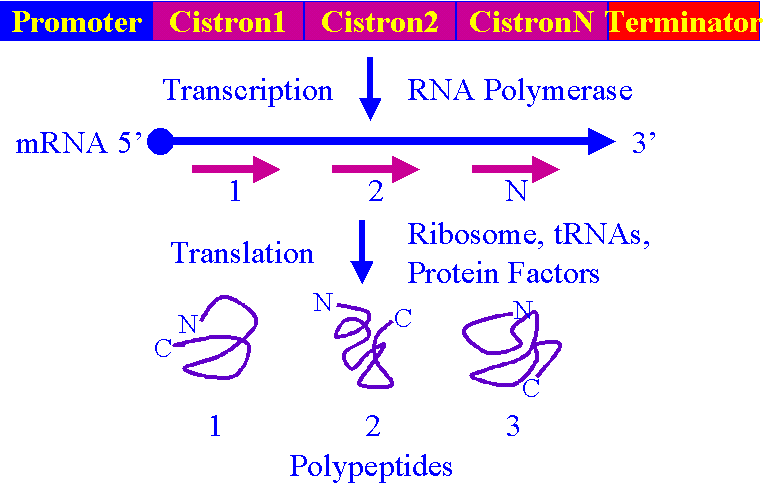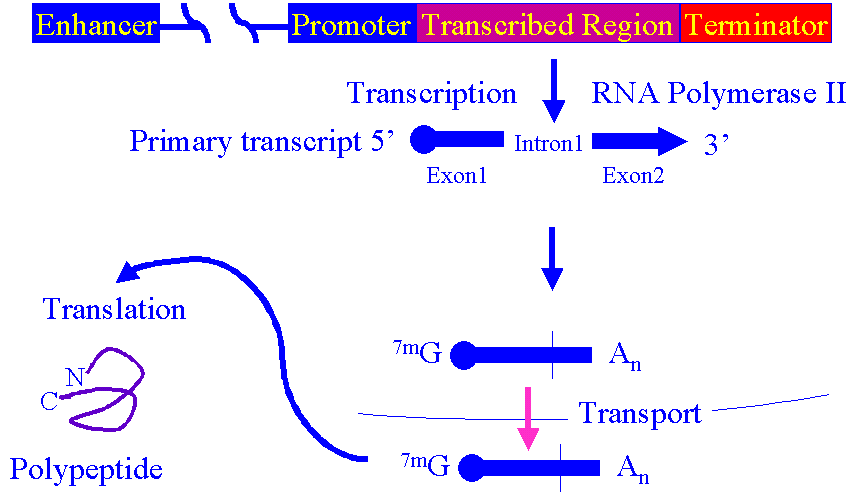-
Organisms
-
Genomes & Genes
-
Proteins
-
Techniques
|
Organism |
E. coli |
Yeast |
Human |
|---|---|---|---|
|
#cells |
1 |
1 |
1012 ? (+commensal bacteria, etc!) |
|
cell size |
1 μm |
5 μm |
10 μm to 1 m! |
|
cell doubling time |
20' |
2 hr |
24 hr or more |
|
taxonomic |
prokaryote |
eukaryote |
eukaryote |
|
mitochondrion |
no |
yes |
yes |
|
metabolism |
ferment respire |
ferment respire |
respire |
|
genome size |
4 Mbp |
12 Mbp |
3000 Mbp |
|
Organism |
Size (Mbp) |
#genes |
gene size (kbp) |
introns (freq) |
Repeat DNA |
|
Mycoplasma (prok) |
0.3 |
300 |
1 |
-- |
0 |
|
E. coli |
4 |
4000 |
1 |
-- |
0 |
|
Yeast (fungus, eukaryote) |
12 |
6000 |
2 |
1% |
5% |
|
Neurospora crassa (fungus) |
40 |
10,000 |
3 |
80% |
10% |
|
Caenorhabditis (worm) |
80 |
20,000 |
10 |
>90% |
50% |
|
Drosophila (fly) |
150 |
20,000 |
10 |
>90% |
50% |
|
Mammal (mouse, man...) |
3000 |
25,000 |
10 |
>90% |
>50% |
|
Arabadopsis (plant) |
300 |
20,000 |
10 |
>90% |
30% |
|
Maize |
6000 |
30,000 |
10 |
>90% |
>50% |
|
Salamander |
25,000 |
25,000 |
10 |
>90% |
>80% |
Remember, you have to have a picture of typical eukaryotic and prokaryotic genes and their elements!
 |
Transcription
Translation
|
 |
Transcription
RNA Processing
Translation
|
Proteins, polypeptides, amino acids
- 20 amino acids KNOW THEM
- Properties,
- 1-letter code, 3-letter code
- Conservative/nonconservative substitution
- MW, amino acid=110 (average)
- Protein size=10 kD to >1000 kD
- Average=30 kD (300 amino acids)
- Modifications
- Methylation, acetylation
- Phosphorylation
- Ubiquitination
- Cleavage
Techniques
- Cloning vectors
- M13, plasmids (1-10 kbp)
- lambda (20 kbp)
- cosmids (40 kbp)
- BACs (100 kbp)
- YACs (1 Mbp)
- DNA sequencing
- 800 bases/run
- ABI3700-type technology, 1000 runs/day
- < $0.01 per raw base
- 99% accurate
- PCR
- 1 molecule template
- 2 kbp easy, 50 kbp limit
- Microarrays
- 40,000 spots per sq. inch
- dynamic range=16-bit, transcripts present 1:100,000 in mRNA
- SDS gels
- resolve to ~5% MW
- 100 ng detection by stain
- Mass-spectroscopy detection limit...